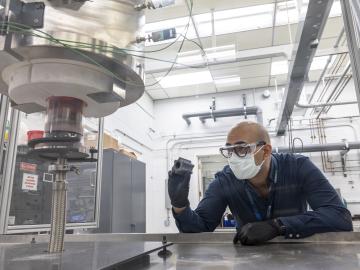
Filter News
Area of Research
- Advanced Manufacturing (2)
- Biological Systems (1)
- Biology and Environment (27)
- Computational Biology (1)
- Computational Engineering (1)
- Computer Science (2)
- Electricity and Smart Grid (2)
- Energy Science (47)
- Functional Materials for Energy (1)
- Fusion and Fission (8)
- Fusion Energy (1)
- Isotopes (5)
- Materials (28)
- Materials for Computing (5)
- National Security (32)
- Neutron Science (17)
- Nuclear Science and Technology (9)
- Quantum information Science (1)
- Supercomputing (60)
News Type
News Topics
- (-) Advanced Reactors (26)
- (-) Biomedical (60)
- (-) Cybersecurity (32)
- (-) Education (5)
- (-) Frontier (62)
- (-) Grid (50)
- (-) Machine Learning (51)
- (-) Polymers (23)
- 3-D Printing/Advanced Manufacturing (110)
- Artificial Intelligence (114)
- Big Data (57)
- Bioenergy (94)
- Biology (106)
- Biotechnology (35)
- Buildings (49)
- Chemical Sciences (72)
- Clean Water (18)
- Composites (24)
- Computer Science (178)
- Coronavirus (36)
- Critical Materials (16)
- Element Discovery (1)
- Emergency (3)
- Energy Storage (77)
- Environment (162)
- Exascale Computing (66)
- Fossil Energy (7)
- Fusion (56)
- High-Performance Computing (117)
- Hydropower (6)
- Irradiation (1)
- Isotopes (55)
- ITER (6)
- Materials (119)
- Materials Science (115)
- Mathematics (8)
- Mercury (9)
- Microelectronics (4)
- Microscopy (41)
- Molten Salt (5)
- Nanotechnology (48)
- National Security (80)
- Neutron Science (141)
- Nuclear Energy (98)
- Partnerships (67)
- Physics (60)
- Quantum Computing (49)
- Quantum Science (81)
- Security (28)
- Simulation (54)
- Software (1)
- Space Exploration (16)
- Statistics (3)
- Summit (63)
- Transportation (62)
Media Contacts

A team of researchers has developed a novel, machine learning–based technique to explore and identify relationships among medical concepts using electronic health record data across multiple healthcare providers.

Unequal access to modern infrastructure is a feature of growing cities, according to a study published this week in the Proceedings of the National Academy of Sciences

ORNL scientists had a problem mapping the genomes of bacteria to better understand the origins of their physical traits and improve their function for bioenergy production.

ORNL and the Tennessee Valley Authority, or TVA, are joining forces to advance decarbonization technologies from discovery through deployment through a new memorandum of understanding, or MOU.

ORNL, TVA and TNECD were recognized by the Federal Laboratory Consortium for their impactful partnership that resulted in a record $2.3 billion investment by Ultium Cells, a General Motors and LG Energy Solution joint venture, to build a battery cell manufacturing plant in Spring Hill, Tennessee.

Three ORNL scientists have been elected fellows of the American Association for the Advancement of Science, or AAAS, the world’s largest general scientific society and publisher of the Science family of journals.

A rapidly emerging consensus in the scientific community predicts the future will be defined by humanity’s ability to exploit the laws of quantum mechanics.

To explore the inner workings of severe acute respiratory syndrome coronavirus 2, or SARS-CoV-2, researchers from ORNL developed a novel technique.

Researchers at ORNL used polymer chemistry to transform a common household plastic into a reusable adhesive with a rare combination of strength and ductility, making it one of the toughest materials ever reported.

A novel method to 3D print components for nuclear reactors, developed by the Department of Energy’s Oak Ridge National Laboratory, has been licensed by Ultra Safe Nuclear Corporation.


